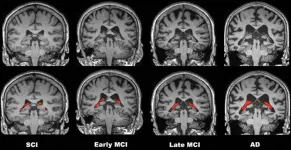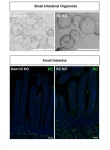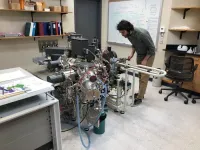(Press-News.org) CHICAGO – Black patients underwent medical imaging for cognitive impairment years later than white and Hispanic patients and were less frequently tested with MRI, according to research being presented this week at the annual meeting of the Radiological Society of North America (RSNA).
Previous studies have shown that Black patients are at increased risk of Alzheimer’s disease and other types of dementia. They are less likely to have a diagnosis and are diagnosed at a more advanced stage of disease compared to white patients.
Medical imaging—ideally with MRI—plays an increasingly important role in the diagnostic work-up of cognitive impairment. However, it is unknown how disparities in imaging access may lead to these delays in cognitive impairment diagnoses.
“If disparity in obtaining access to neuroimaging is one possible barrier that delays diagnosis, it is important to identify this and figure out possible solutions to benefit these patients and prevent a delayed diagnosis,” said study lead author Joshua Wibecan, M.D., radiology resident at Boston Medical Center in Boston, Massachusetts.
Drawing from four years of data, Dr. Wibecan and colleagues studied imaging disparities at their safety net academic medical center. A safety net medical center provides health care for people regardless of their insurance status or ability to pay.
The researchers identified all outpatient CTs of the head, CT angiographies of the head and MRI brain examinations performed for cognitive impairment. They obtained patient self-identified race from the Boston Medical Center Clinical Data Warehouse for Research.
Self-identified Black/African American patients were imaged for cognitive impairment at an older age and were less frequently imaged for cognitive impairment with MRI. While CT and MRI can both be useful in detection of cognitive impairment and dementia diagnoses, MRI provides much more detail about brain abnormalities.
The average age at imaging for cognitive impairment among the groups with Black patients was 72.5 years, compared with 67.8 years for white patients, 66.5 years for Hispanics and 66.7 years for the Other group. Only 50.9% of Black patients underwent MRI testing for cognitive impairment, compared to 60% of white patients, 67% of Hispanics and 68.2% in the Other group.
“Our study demonstrates two main findings,” Dr. Wibecan said. “First, Black patients who received MRI or CT for cognitive impairment were significantly older than patients from other races. Second, Black patients were significantly less likely to be imaged with MRI, the optimal type of imaging for cognitive impairment, as opposed to CT.”
Early imaging evaluation is important to identify treatable causes of cognitive impairment, such as tumors, bleeding or swelling within the brain. Additionally, new treatments have recently become available for Alzheimer’s disease that can potentially slow the rate of decline. Earlier diagnosis may, therefore, lead to early treatment and a longer period of better cognitive function.
“As treatment for Alzheimer’s Disease improves, it will be even more important to identify patients at early stages of disease for optimal treatment,” Dr. Wibecan said.
Further research is needed, Dr. Wibecan said, to understand why there was a significant difference in the types of imaging exams ordered for the workup of cognitive impairment across racial groups.
Chad W. Farris, M.D., Ph.D., neuroradiologist from Boston Medical Center and assistant professor of radiology at Boston University Chobanian & Avedisian School of Medicine, co-authored the study.
###
Note: Copies of RSNA 2023 news releases and electronic images will be available online at RSNA.org/press23.
RSNA is an association of radiologists, radiation oncologists, medical physicists and related scientists promoting excellence in patient care and health care delivery through education, research and technologic innovation. The Society is based in Oak Brook, Illinois. (RSNA.org)
Editor’s note: The data in these releases may differ from those in the published abstract and those actually presented at the meeting, as researchers continue to update their data right up until the meeting. To ensure you are using the most up-to-date information, please call the RSNA Newsroom at 1-312-791-6610.
For patient-friendly information on brain MRI and CT, visit RadiologyInfo.org.
END
About 1 in 10 prescription drugs — mainly brand-name and expensive drugs and those for rare diseases — has a manufacturer-sponsored patient support program, which usually includes financial, nursing and educational supports.
"In an era where policy-makers are grappling with escalating drug prices and budgetary impacts globally, the pharmaceutical industry promotes patient support programs as adding complementary value to a drug through supporting medication adherence and enhancing clinical outcomes, patient experience or quality of life," ...
Health Canada increased maximum residue limits for glyphosate in some crops, such as oats and beans, in 2021 despite concerns about the health impact of glyphosate-based herbicides (GBHs). The World Health Organization's (WHO) International Agency for Research on Cancer regards these pesticides as genotoxic, meaning they can damage DNA and are likely carcinogenic.
"Health Canada's PMRA considers pesticide sales and risk evaluation data in Canada to be confidential business information, and independent researchers cannot access these data, even through the Access to Information Act. Such ...
Stem cells can differentiate to replace dead and damaged cells. But how do stem cells decide which type of cell to become in a given situation? Using intestinal organoids, the group of Bon-Kyoung Koo at IMBA and the Institute for Basic Science identified a new gene, Daam1, that plays an essential role, switching on the development of secretory cells in the intestine. This finding, published on November 24 in Science Advances, opens new perspectives in cancer research.
Our bodies are, in some ways, like cars – to keep functioning, they need to be checked and repaired regularly. In the case of our bodies, ...
The Fens of eastern England, a low-lying, extremely flat landscape dominated by agricultural fields, was once a vast woodland filled with huge yew trees, according to new research.
Scientists from the University of Cambridge studied hundreds of tree trunks, dug up by Fenland farmers while ploughing their fields. The team found that most of the ancient wood came from yew trees that populated the area between four and five thousand years ago.
These trees, which are a nuisance when they jam farming equipment during ploughing, contain a treasure trove of perfectly preserved ...
A new study led by UCL researchers confirms that autistic people experience a reduced life expectancy, however the number of years of life lost may not be as high as previously claimed.
The research, published in The Lancet Regional Health – Europe, is the first to estimate the life expectancy and years of life lost by autistic people living in the UK.
The team used anonymised data from GP practices throughout the UK to study people who received an autism diagnosis between 1989 to 2019. They ...
Plants have no visual organs, so how do they know where light comes from? In an original study combining expertise in biology and engineering, the team led by Prof Christian Fankhauser at UNIL, in collaboration with colleagues at EPFL, has uncovered that a light-sensitive plant tissue uses the optical properties of the interface between air and water to generate a light gradient that is 'visible' to the plant. These results have been published in the journal Science.
The majority of living organisms (micro-organisms, plants and animals) have the ability to determine the origin of a light source, even in the absence of a sight organ comparable to the eye. This information is invaluable ...
E. coli bacteria may be far more capable at evolving antibiotic resistance than scientists previously thought, according to a new study published in Science on November 24.
Led by SFI External Professor Andreas Wagner, the researchers experimentally mapped more than 260,000 possible mutations of an E. coli protein that is essential for the bacteria’s survival when exposed to the antibiotic trimethoprim.
Over the course of thousands of highly realistic digital simulations, the researchers then found that 75% of all possible evolutionary paths of the E. coli protein ultimately ...
Blame it on plate tectonics. The deep ocean is never preserved, but instead is lost to time as the seafloor is subducted. Geologists are mostly left with shallower rocks from closer to the shoreline to inform their studies of Earth history.
“We have only a good record of the deep ocean for the last ~180 million years,” said David Fike, the Glassberg/Greensfelder Distinguished University Professor of Earth, Environmental, and Planetary Sciences in Arts & Sciences at Washington University in St. Louis. “Everything else is just shallow-water deposits. So it’s really important to understand the bias that might be present when we look ...
Addressing the long-standing “dolomite problem,” an oddity that has vexed scientists for nearly 200 years, researchers report that dolomite crystals require cycling of saturation conditions to grow. The findings provide new insights into how dolomite is formed and why modern dolomite is primarily found in natural environments with pH or salinity fluctuations. Dolomite – a calcium magnesium carbonate – is one of the major minerals in carbonate rocks, accounting for nearly 30% of the sedimentary carbonate minerality in Earth’s crust. However, despite its geological abundance, dolomite does not readily grow under laboratory conditions, ...
Using a new algorithm called FLSHclust (“flash clust”), researchers have discovered 188 rare and previously unknown CRISPR-linked gene modules – including a novel type VII CRISPR-Cas system – among billions of protein sequences. The approach and its findings provide novel opportunities for harnessing CRISPR systems and understanding the vast functional diversity of microbial proteins. CRISPR systems have been leveraged to develop a growing suite of novel biomolecular approaches, including CRISPR/Cas-mediated genome editing. The discovery ...





